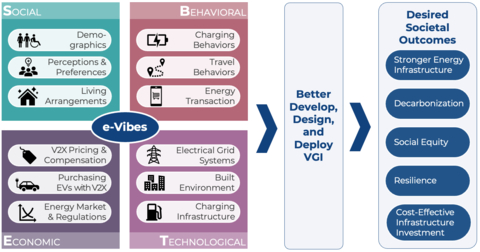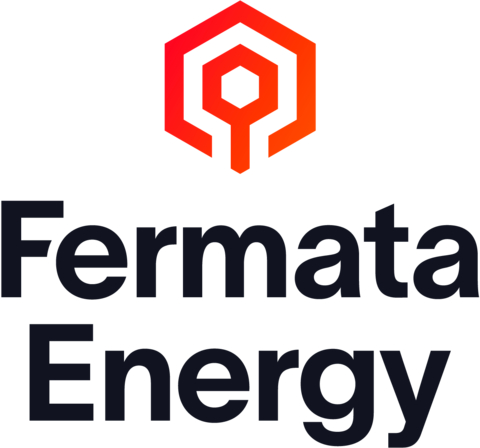Fermata Energy Collaborates with NSF-Funded Research Team to Strengthen American Infrastructure through Vehicle-Grid Integration (VGI)
Fermata Energy Collaborates with NSF-Funded Research Team to Strengthen American Infrastructure through Vehicle-Grid Integration (VGI)
CHARLOTTESVILLE, Va.--(BUSINESS WIRE)--Fermata Energy is proud to announce its advisory role in a prestigious three-year research initiative funded by the National Science Foundation (NSF). The project, Electric Vehicle Integration to power infrastructure by Behavioral, Economics, and Sociotechnical modeling (E-VIBES), is led by an interdisciplinary team at the University of Colorado-Denver, North Carolina State University, Gettysburg College, and Colorado Smart Cities Alliance. It aims to enhance the resilience and efficiency of America's infrastructure through Vehicle-Grid Integration (VGI) system development.
This NSF-funded research, under the Strengthening American Infrastructure (SAI) program, seeks to transform how energy and information flow between electric vehicles (EVs) and the electric grid. Addressing the pressing issues of frequent power outages and rising energy costs, this initiative leverages the potential of EVs as backup power sources, cost-saving tools, and supports grid stability and renewable energy integration.
Key Research Areas:
- Economic, Behavioral, and Technical Concepts: Developing a comprehensive VGI system.
- User-Friendly VGI Services: Identifying pricing mechanisms and institutional arrangements.
- Power Flow Studies: Ensuring the grid can handle VGI and optimizing EV charging and discharging.
- Socio-Economic Disparities: Understanding consumer willingness and equitable benefit distribution.
- Machine Learning and Data Analysis: Creating models to predict VGI adoption and usage patterns.
Fermata Energy will provide expert guidance on the development and implementation of VGI systems, ensuring that the project benefits from cutting-edge industry insights and practical experience. This collaboration enhances the potential for real-world application and impact.
“The integration of electric vehicles into our energy grid is poised to revolutionize energy management,” said Tony Posawatz, CEO of Fermata Energy. “Our role in this research will ensure that Vehicle-Grid Integration systems are not only innovative and efficient but also accessible and beneficial to all, bridging socio-economic gaps in energy access.”
This award, supported by the Directorate for Social, Behavioral, and Economic (SBE) Sciences, reflects NSF's commitment to advancing research with significant intellectual merit and broad societal impacts.
“Collaborating with Fermata Energy has provided a vital link between our research and real-world application,” said Serena Kim, Project Co-Lead at North Carolina State University. “By leveraging insights from V2X system users, owners, and potential adopters, we are addressing critical challenges in energy pricing, EV ownership costs, and regulatory frameworks to support the wider deployment of V2X systems. This partnership allows us to develop solutions that are not only technologically advanced but also sustainable and equitable, ensuring a more resilient energy future for all communities.”
Recent Announcements from Fermata Energy:
-
Xcel Energy Partnership: Fermata Energy, Xcel Energy, the City of Boulder, Colorado CarShare, and Boulder Housing Partners launched a Vehicle-to-Everything (V2X) bidirectional charging pilot at Boulder Housing Partners’ 30 Pearl development and Molly's Spirits Lakeside facility. This project transforms parked EVs into mobile power units, enhancing grid resilience, reducing electric bills, and supporting local communities.
- California V2G Bus Project: The California Energy Commission (CEC) awarded a $3 million grant to BorgWarner, Fermata Energy, and Lion Electric for a Vehicle-to-Grid (V2G) project with American Transportation. This initiative uses electric school buses to support grid reliability and provide emergency power, optimizing charging and discharging with Fermata Energy's V2X software to lower costs and support California's clean energy goals.
Fermata Energy continues to pioneer the integration of EVs with the energy grid through its Vehicle-to-Everything (V2X) technology, transforming parked EVs into valuable energy assets and contributing to a more resilient and sustainable energy grid.
For more information, visit Fermata Energy's website.
About Fermata Energy
Fermata Energy is a leading platform services provider of intelligent Vehicle-to-Everything (V2X) bidirectional charging technology, including Vehicle-to-Grid (V2G), Vehicle-to-Home (V2H), and Vehicle-to-Building (V2B) solutions. The company was founded in 2010 to accelerate the adoption of bidirectional energy technology solutions through inspiration and innovation. Fermata Energy’s proprietary technology enables its customers to manage EVs as distributed energy resources by selling excess energy stored in parked EV batteries to offset costly peak demand charges. To learn more about Fermata Energy, please visit https://fermataenergy.com/ and follow the company on LinkedIn.
About E-VIBES
E-VIBES is a US National Science Foundation-supported project exploring how enhancing the exchange of energy and information between electric vehicles (EVs) and the electric grid can benefit people. E-VIBES’ framework integrates social science and engineering methods and models to analyze the development, design, and deployment of VGI.
Contacts
Fermata Energy Media Contact:
media@fermataenergy.com

